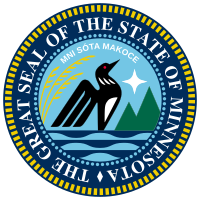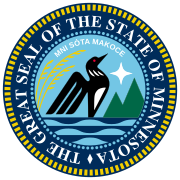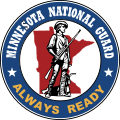
Minnesota is a state in the Upper Midwestern region of the United States. It is the 12th largest U.S. state in area and the 22nd most populous, with over 5.75 million residents. Minnesota is known as the "Land of 10,000 Lakes" but actually has 14,380 bodies of fresh water covering at least ten acres each; roughly a third of the state is forested; much of the remainder is prairie and farmland. More than 60% of Minnesotans live in the Minneapolis–Saint Paul metropolitan area, known as the "Twin Cities", the state's main political, economic, and cultural hub and the 16th-largest metropolitan area in the U.S. Other minor metropolitan and micropolitan statistical areas include Duluth, Mankato, Moorhead, Rochester, and St. Cloud.

The flags of the U.S. states, territories, and the District of Columbia exhibit a variety of regional influences and local histories, as well as different styles and design principles. Modern U.S. state flags date from the turn of the 20th century, when states considered distinctive symbols for the 1893 World's Columbian Exposition in Chicago, Illinois. Most U.S. state flags were designed and adopted between 1893 and World War I.

The flag of Minnesota is the state flag of the U.S. state of Minnesota. Its design features a light blue field with a shape on the hoist representing the shape of Minnesota, with a star representing the North Star. It was adopted on May 11, 2024.

The current flag of South Dakota was adopted in 1992 to represent the U.S. state of South Dakota. It consists of a field of sky blue charged with a version of the state seal in the center, surrounded by gold triangles representing the sun's rays, surrounded in turn by inscriptions in gold sans-serif capitals of "south dakota" on top and "the mount rushmore state" on the bottom. The sun represents the common weather in South Dakota.

The Minnesota Supreme Court is the highest court in the U.S. state of Minnesota. The court hears cases in the Supreme Court chamber in the Minnesota State Capitol or in the nearby Minnesota Judicial Center.

The U.S. state of New Hampshire has held two seals since it declared its independence from Great Britain on January 5, 1776. While both seals have been retained, most people are only familiar with the Great Seal due to its corporate use.

The Great Seal of the Commonwealth of Massachusetts contains the coat of arms of Massachusetts. The coat of arms is encircled by the Latin text "Sigillum Reipublicæ Massachusettensis". The Massachusetts Constitution designates the form of government a "commonwealth", for which respublica is the correct Latin term. The seal uses the coat of arms of Massachusetts as its central element.

The state auditor of Minnesota is a constitutional officer in the executive branch of the U.S. state of Minnesota. Nineteen individuals have held the office of state auditor since statehood. The incumbent is Julie Blaha, a DFLer.
Fair debt collection broadly refers to regulation of the United States debt collection industry at both the federal and state level. At the Federal level, it is primarily governed by the Fair Debt Collection Practices Act (FDCPA). In addition, many U.S. states also have debt collection laws that regulate the credit and collection industry and give consumer debtors protection from abusive and deceptive practices. Many state laws track the language of the FDCPA, so that they are sometimes referred to as mini-FDCPAs.
In the United States, the law for murder varies by jurisdiction. In many US jurisdictions there is a hierarchy of acts, known collectively as homicide, of which first-degree murder and felony murder are the most serious, followed by second-degree murder and, in a few states, third-degree murder, which in other states is divided into voluntary manslaughter, and involuntary manslaughter such as reckless homicide and negligent homicide, which are the least serious, and ending finally in justifiable homicide, which is not a crime. However, because there are at least 52 relevant jurisdictions, each with its own criminal code, this is a considerable simplification.
The copyright status of works produced by the governments of states, territories, and municipalities in the United States varies. Copyright law is federal in the United States. Federal law expressly denies U.S. copyright protection to two types of government works: works of the U.S. federal government itself, and all edicts of any government regardless of level or whether or not foreign. Other than addressing these "edicts of government", U.S. federal law does not address copyrights of U.S. state and local government.

Peter Fischer is an American politician serving in the Minnesota House of Representatives since 2013. A member of the Minnesota Democratic–Farmer–Labor Party (DFL), Fischer represents District 44A in the central Twin Cities metropolitan area, which includes the cities of Maplewood, Little Canada, and North St. Paul, and parts of Ramsey County.

Bdóte is a significant Dakota sacred landscape where the Minnesota and Mississippi Rivers meet, encompassing Pike Island, Fort Snelling, Coldwater Spring, Indian Mounds Park, and surrounding areas in present-day Minneapolis and Saint Paul, Minnesota, United States. In Dakota geographic memory, it is a single contiguous area not delineated by any contemporary areas' borders. According to Dakota oral tradition, it is the site of creation; the interconnectedness between the rivers, earth, and sky are important to the Dakota worldview and the site maintains its significance to the Dakota people.
















